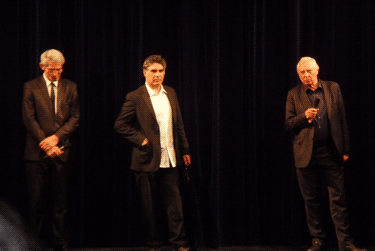Cannes 2013.
| Hardly any films show political engagement or social critique, as if the defeatist acceptance of mainstream values, relativisation of normative standards and petty (pseudo)individualistic concerns had taken precedence over attempts at challenging the set boundaries and artistic search for reflexive criticism, perhaps symptomatic of the age we live in. There were entertaining comedies Les garcons et Guillaume, a table! and Tip top, by Guillaume Gallienne and Serge Bozon respectively, contemplative Sebastien Pilot's Demantelement, Ritesh Batra's lyrical urban story The Lunchbox, a daring documentary experiment L'Escale by Kaveh Bakhtiari, and an unpretentious exercise in realism in The Selfish Giant by Clio Barnard.
The screened films vary in their cinematic approaches to portrayals of different realities and human relationships, mainly focusing on the common topics of isolation, outcastness, or yearning to belong somewhere. Blue Ruin, this year's award winning Fipresci gem directed by American Jerome Saulnier, efficiently conveys the feeling of isolation, as the protagonist sets off for his childhood home to carry out an act of revenge. Ilo ilo is directed by Anthony Chen, the first Singapore author to win accolades in Cannes: first, a special mention for his short Ah Ma (Grandma) in 2007, and this year the prestigious Camera d'Or for Ilo Ilo, awarded by an impressive jury presided by Agnès Varda. Set in Singapore at the time of the 1997 Asian financial crisis, and masterfully shot in a minimalist retro style, Ilo ilo depicts a family in tension, intensified by the arrival of a Filipino maid. Another successful film on isolation and loneliness is Henri, second feature by Yolande Moreau, an established theatre and film actress, whose debut feature Quand la mer monte... won Louis-Delluc prize for best first film and two Césars, for best film and best actress. Other films that stood out also were Salvo, by F Grassadonia and A Piazza, thanks to its elaborated mise-en-scene, La Danza de la Realidad and Un voyageur with stylish visions of their masters Alejandro Jodorowsky and Marcel Ophuls, respectively, and an illuminating documentary on Jodorowsky's failed project Dune, by Frank Pavich. However, if I had to single out one film for which it was worth going to Cannes, it would be the second part of the triptych 3x3D, screened unfortunately only once, on the Semaine de la Critique closing night. Set in the millennium old city of Guimaraes, the European Capital of Culture 2012, three renowned film authors, Peter Greenaway, Jean-Luc Godard and Edgar Pera join forces in the symptomatically entitled trilogy 3x3D, to explore 3D and its influence on our perception of cinema. The first piece Just in Time, by Peter Greeenaway, is an 18 minutes-long totemic gaze on 2000 years of Portugese history. Set in Guimaraes, the same 5 minutes sequence-shot is repeated three times – in the morning, at noon and in the evening – tracing Guimaraes historical city and its heroes from its Christian beginnings, to the Gothic and the Renaissance, and to the modern era, whilst exploring the possibilities of 3D. The third piece of this 3D triptych is Edgar Pera's Cinesapiens, a neo-cinema situated between kino-theory and cinematic practice. It centres on Cinesapiens, a monster created by Kino-Frankestein, who looks at the screen-mirror and sees there the entire condensed Cinema history. Exploring the potentials of 3D in many theatrical 3D proclamations – such as "emancipation is blurring boundaries between those who act and those who look, between individuals and community members", or "(pure) voyeurism opposes continuous curiosity for films and knowledge - Cinesapiens declares "death to the realists" and loudly celebrates this monstrous 3D creature. |
 Godard's The Three Disasters (Les Trois Desastres) is a marvelous 3D symbolic, technical and narrative play of images, history, knowledge, space, time, dimensions, human perception and its limitations. It is the best film history film screened so far, all in a densely condensed piece of 20 minutes. By analogy, it is the best film on human history too. Asking the essential questions on cinema, arts, civilization, human memory and politics: "What is a man? A city? A war? A memory...", in a typically Godardian semantic and poetic play, the author masterfully juxtaposes images of war, ravaged cities, historical spaces created and destroyed by man, "shadows", technological and scientific progresses and retrogressions (the analogical vs. digital, the significance of numbers, "0,1... negative numbers introduced by Hindus"). The visual and the verbal narrative are here in perfect harmony, hardly found in any films, 3D or non-3D. Godard's 3D screen confronts us with a Borgesian labyrinth of lines, shapes, colours, perspectives and multilingual puns – dés(astres), astral dice, dice, stars, disasters – along multiplied and intensified images, echoing words 'on the screen and around us'. While "words are here to express something that doesn't exist in the reality", they are necessary. Is 3D "really" necessary? In our perfected search for more image reality, we ended up with more illusory space-time than ever, seated in a dark cinema space with 3D glasses to watch a single screen. In fact, thinking we are closer to the real, multiple screen realities multiply our illusions, by analogy to numbers (numérique/digital, digits, numbers, metaphors abound). From 1 to 3, how did we get here? This reality of the human eye "is bizarre", claims Godard. First films used 1 (camera) eye to be watched with 2 eyes, and now we use 2 eyes to watch 3D, "it's really bizarre"... Intentionally making it difficult, almost impossible, for the spectators to follow, and demanding all our psychological, cognitive, emotional and visual attention to the 'complex and rich on-screen reality', Godard issues his final ironic statement on 3D: "writing was necessary, painting was jouissance, 3D is dictatorship." Jean-Luc Godard's "Les trois desastres" is, by far, the most interesting film I have seen at this year's Cannes festival. And most probably, the only masterpiece, albeit short and 3D. If Jim Jarmusch makes another vampire film on cultural heritage, Godard should be his most inspiring and exciting timeless vampire. Maja Bogojević |

